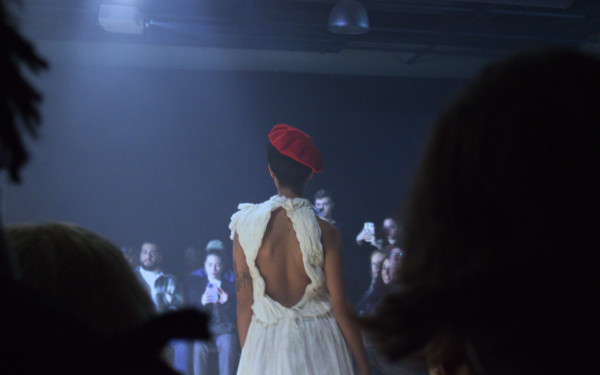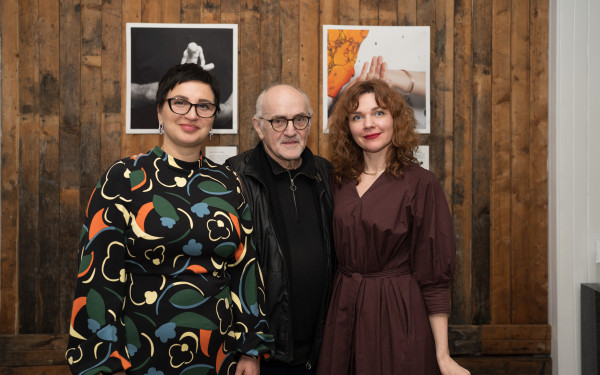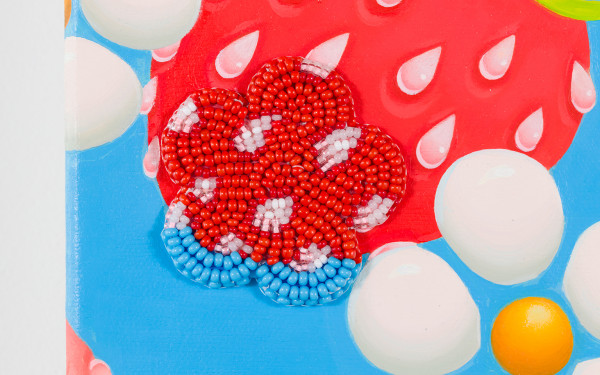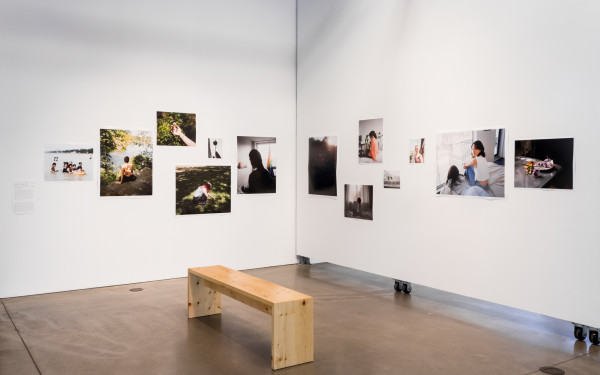Honouring water through Indigenous fashion
The McCord Museum and BACA present “kisewâtisiw miyootootow”
Co-curated by Armando Perla, chief curator of the Textile Museum of Canada, and Jason Baerg, a multidisciplinary Métis artist, “kisewâtisiw miyootootow – S/he is Mercifully” was presented in conjunction with Baerg’s exhibition at Art Mûr from Jan. 13 to Feb. 24.
Doors opened at 7:30 p.m. and the show kicked off at 8 p.m. It lasted about forty minutes.
The show began with three original pieces by Montreal-based Anishinaabe and French visual artist Caroline Monnet and then proceeded with Baerg’s creations.
The venue was an open space with a room featuring black bleachers where people could sit or stand. The museum buzzed with activity, with people lining up outside as they waited to be let in. Attendees of diverse backgrounds and ages mingled throughout the space, creating a vibrant ambiance.
Sponsored by the McCord Stewart Museum, Textile Museum of Canada, Art Mûr, and BACA, the show featured a screen displaying Baerg's art.
BACA is a non-profit organization dedicated to recognizing and supporting contemporary Indigenous art and artists. They host program events every two years and special projects throughout the year.
There were complimentary wine stations and sounds from a live DJ playing music by Indigenous artists filled the room. Additionally, guests had the opportunity to explore a Wampum exhibition upstairs following the fashion show’s conclusion.
Embracing their role as an Indigenous futurist, Baerg drew inspiration from the concept of metamorphosis, highlighting the imperative for profound respect, love, and care for his own community.
Baerg embarked on a four-year project to explore and integrate the profound teachings of the Cree medicine wheel. Each year, they aim to honor a specific aspect of the wheel through their studio artistic practice. With works created during the winter and fall 2023, these pieces reflect the transition period of the medicine wheel, incorporating elements from the south such as earth and metal, as well as elements from the west, such as water, sage and the colour blue.
“I’m really interested in opening the Indigenous imaginary to concepts of arriving safely. I wanna inspire the youth to fulfill all of their dreams,” Baerg said. “But first, they have to dream. First, we have to imagine. I’m interested in effective manners of engagement, and I’m really thinking about my motivation in that space. So for this body of work, I’m interested in elevating space for peace and radical Indigenous love.”
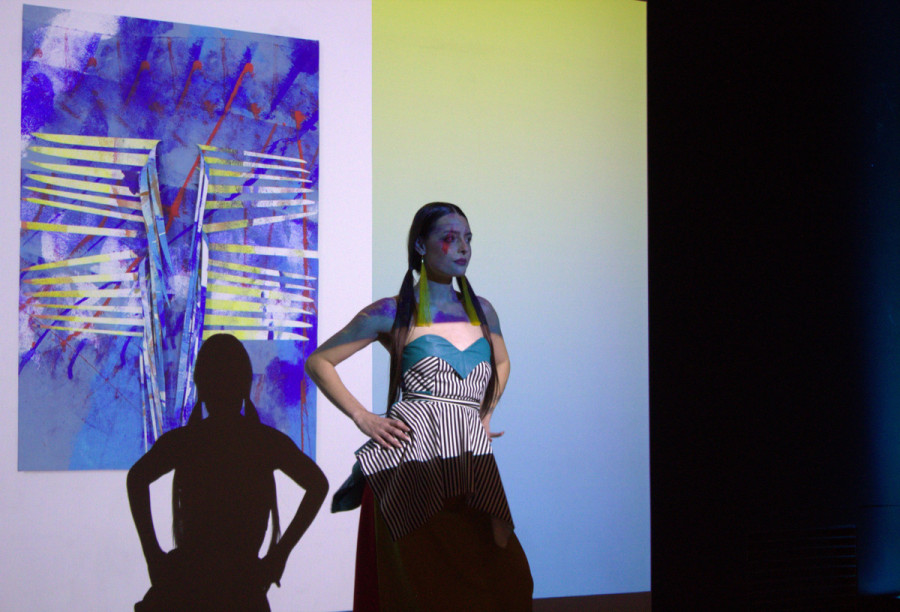
Baerg has always been influenced and affected by fashion; they’ve been presenting formally since 2020. Last summer they presented at the National Gallery of Canada and they are one of the first artists to ever present fashion in that context of putting Indigenous voices at the forefront. They have had pieces in museum shows, notably in the Queen’s Square Gallery and Preston Gallery. They are interested in integrating the runway into contemporary art institutions.
Noting the prevalence of blue in the “kisewâtisiw miyootootow” installation, Baerg emphasized the significance of water, referencing Montreal's island location and the traditional territory of Haudenosaunee, including individuals from Kahnawake as casted models.
“When we think about institutionalizing, iconicizing garments, it’s really about the person on whom that work is,” they added. “When I think about monumentalizing a human, I’m really interested in who they are as humans. Sure, you might be what is textbook beautiful, but do you have something original to say, are you supporting a cause or a people that deserve our attention? When I’m casting models, I’m interested in people who are making massive contributions, who will elevate and inspire others.”
Regarding balancing traditional and contemporary influences in their design, Baerg introduced the concept of atemporality, which challenges the linear perception of time. They explained that time is circular, evidenced by various cyclical phenomena like seconds, minutes, hours and moon cycles. Baerg emphasized the importance of integrating wisdom from the past while also addressing contemporary challenges such as plastics and overproduction in fashion. They expressed a commitment to sustainability and a holistic approach to fashion, viewing it as a reflection of people's lives.
"I work with natural materials: silk, leather, cotton. Triangles can create an up or down movement of the eye,” said Baerg. “The way we position a triangle will affect our relationship to the body, to the sky, to the earth. We're drawing attention to specific things. I use geometries, very specifically very intentionally. Geo means Earth, and metric is measurement. It's all about Earth measurements, it's all about those relationships. Everything is part of a greater cosmology."
Michael Patten, director of the BACA, who is Cree and a member of the Zagime Anishinabek First Nations in Saskatchewan, shared how the idea for the Indigenous fashion show originated. The museum's enthusiasm for the concept played a crucial role in finalizing the decision to showcase Baerg’s and Monnet’s creations. Over the years, BACA and the McCord Museum cultivated a longstanding relationship, starting back in 2012. This collaboration has involved various projects.
"Jason proposed the idea to us based on their prior experience with fashion shows, including one at the National Gallery,” said Patten. “They were looking for a venue to host a show parallel to the exhibition here. I immediately thought of the McCord because they have a long-standing history and interest in collaborating with Indigenous artists and supporting them.”
This article originally appeared in Volume 44, Issue 11, published March 5, 2024.

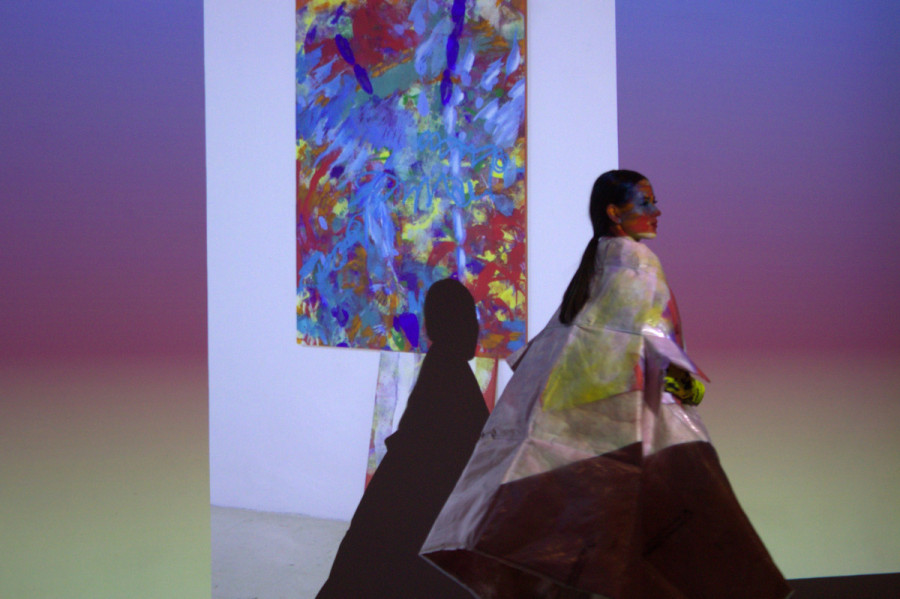
_600_832_s.png)

